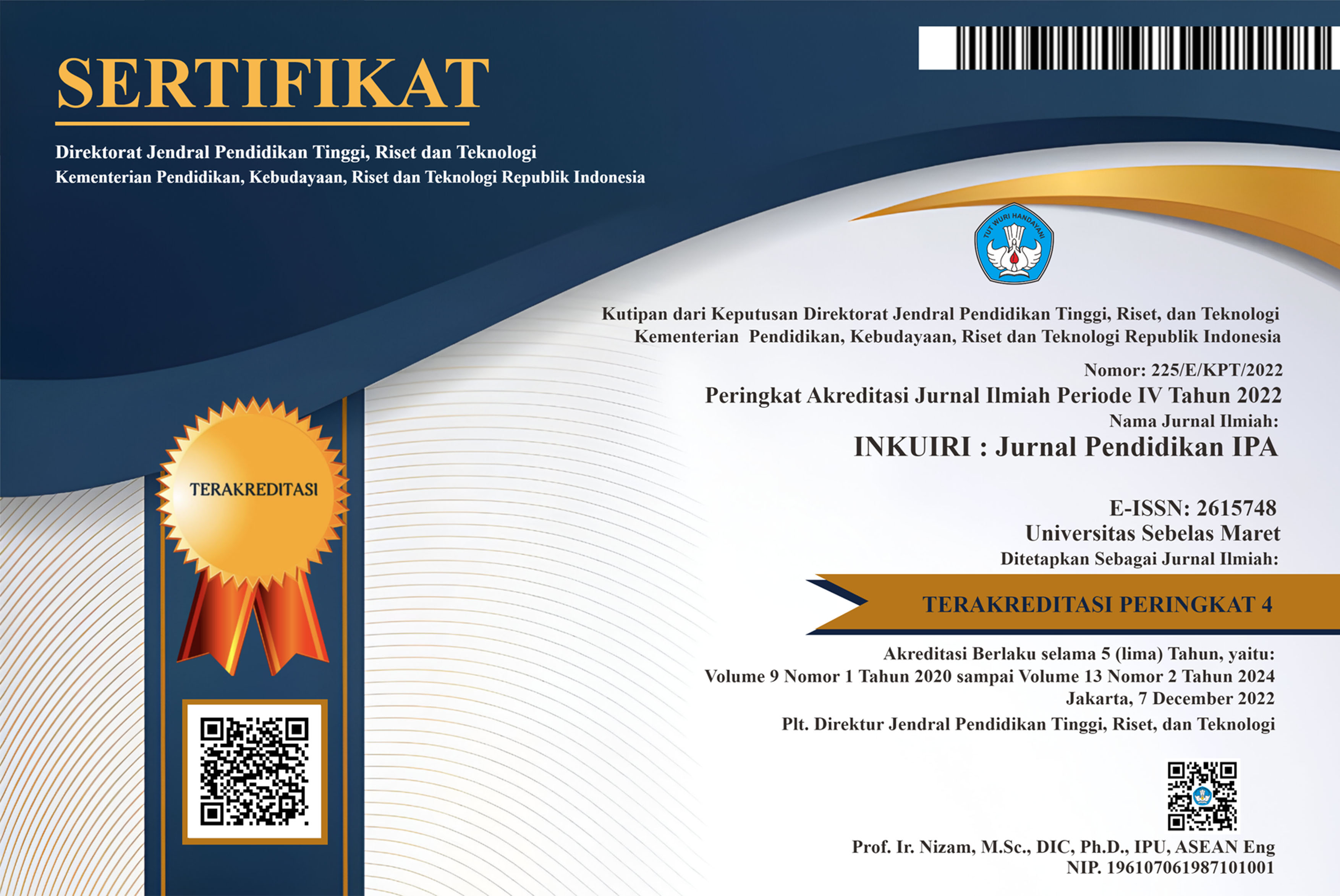Penerapan Metode Pacing dan Dual Processing untuk Mencegah Beban Kognitif Berlebih Siswa dalam Pembelajaran Fisika
Abstract
Telah dilakukan penelitian tindakan kelas untuk mengurangi beban kognitif siswa dalam pembelajaran fisika di kelas XI MIPA 1 SMA Negeri 1 Mantup. Tujuan dari penelitian adalah 1) mendeskripsikan keterlaksanaan penerapan metode pacing dan dual processing, 2) Mendeskripsikan perilaku yang ditunjukkan oleh siswa berkaitan dengan beban kognitif yang dialami, dan 3) mendeskripsikan beban kognitif yang dialami oleh siswa. Penelitian tindakan ini dilakukan sebanyak dua siklus yang masing-masing terdiri dari tahap perencanaan (plan), pelaksanaan dan observasi (action and observe) dan refleksi (reflection). Data diperoleh dari hasil obervasi keterlaksanaan penerapan metode, observasi perilaku siswa yang berhubungan dengan beban kognitif, dan angket beban kognitif siswa selama pembelajaran. Berdasarkan hasil analisis data diperoleh keterlakasanaan pembelajaran rata-rata hanya sampai tahap menyimpulkan dan hanya satu kali pertemuan yang sampai kegiatan penutup. Perilaku siswa menunjukkan beban kognitif yang rendah dialami oleh siswa dari siklus I dan siklus II, dengan perilaku pada siklus II lebih rendah dibandingkan pada siklus I. Beban kognitif total siswa termasuk kategori rendah baik siklus I maupun siklus II yaitu siklus I sebesar 10,44 dari 30 dan siklus II sebesar 10,84 dari 30.
Class action research has been carried out to reduce students' cognitive load in learning physics in class XI MIPA 1 SMA Negeri 1 Mantup. The aims of the research are 1) to describe the implementation of the pacing and dual processing methods, 2) to describe the behavior shown by students in relation to the cognitive load experienced, and 3) to describe the cognitive load experienced by students. This action research was carried out in two cycles, each consisting of planning, implementation and observation and reflection stages. Data was obtained from observations of the implementation of the method, observations of student behavior related to cognitive load, and questionnaires on students' cognitive load during learning. Based on the results of data analysis, it was found that learning progress was on average only up to the concluding stage and only one meeting ended with the closing activity. Student behavior shows a low cognitive load experienced by students from cycle I and cycle II, with behavior in cycle II being lower than in cycle I. The total cognitive load of students is in the low category for both cycle I and cycle II, namely cycle I is 10.44 of 30 and cycle II was 10.84 out of 30.
Full Text:
PDFReferences
Bannert, Maria. (2002). Managing cognitive load—recent trends in cognitive load theory. Learning and Instruction 12, 139–146.
BSNP. 2014. Penilaian Hasil Belajar Oleh Pendidik Pada Pendidikan Dasar Dan Pendidikan Menengah. Jakarta: Depdiknas.
Chinnappan, M. & Chandler, P. A. (2010). Managing cognitive load in the mathematics classroom. Australian Mathematics Teacher, 66 (1), 5-11.
Dehn, Milton J. 2008. Working Memory and Academic Learning Assessment and Intervention. United State of America: John Wiley &Sons, Inc.
Dehn, Milton J. 2014. Essentials of Processing Assessment Second Edition. United State of America: John Wiley &Sons, Inc.
Feldon, David F. 2007.Cognitive Load and Classroom Teaching: The Double-Edged Sword of Automaticity.Educational Psychologist, 42(3), 123-137.
Fred Paas, Fred et. al. (2010). Cognitive Load Theory and Instructional Design: Recent Developments. Educational Psychologist, 38(1), 1–4.
Kalyuga, S. 2011. Informing: A Cognitive Load Perspective. Informing Science: the International Journal of an Emerging Transdiscipline. 14 (1): 33-45.
Kirschner , Paul A. (2002). Cognitive load theory: implications of cognitive load theory on the design of learning. Learning and Instruction 12 (2002) 1–10.
Kreitler, Shulamith. 2013. Cognition and Motivation: Forging an Interdiciplinary Perspective. United States of America: Cambridge University Press.
Leppink ,Jimmie et. al.2013.Development of an instrument for measuring different types of cognitive load.Article in Behavior Research Methods April 2013.
Lieberman, David A. 2012. Human Learning and Memory. United States of America: Cambridge University Press.
Mayer , Richard E. Dan Roxana Moreno. (2003). Nine Ways to Reduce Cognitive Load in Multimedia Learning. Educational Psychologist, 38(1), 43–52.
Miller, G. (1956). The magical number seven, plus or minus two: Some limits on our capacity for processing information. Psychological Review, 63, 81–97.
Mills, Geoffrey E. dan Lorraine R. Gay. 2016. Educational Research: Competencies for Analysis and Applications 11th Edition. United States of America:Pearson.
Moreno, R., & Mayer, R. E. (2000a). A coherence effect in multimedia learning: The case for minimizing irrelevant sounds in the design of multimedia messages. Journal of Educational Psychology, 92, 117–125.
Moreno, Roxana. 2010. Educational Psychology. United State of America: John Wiley &Sons, Inc.
Myers, David G. 2013. Psychology Tenth Edition. United State of America: Worth Publishers.
PAAS , FRED et. al (2004). Cognitive Load Theory: Instructional Implications of the Interaction between Information Structures and Cognitive Architecture. Instructional Science 32: 1–8.
Prabowo. 2011. Metodologi Penelitian: Sains dan Pendidikan Sains. Surabaya: UNESA University Pers.
Rahmat, Adi dkk. 2015. Beban Kognitif dan kemampuan penalaran siswa SMA, MA, dan SMA berbasis pesantren pada pembelajaran Biologi. Semnas Sains dan Entrepreneurship II.240-245.
Shaffer, Dale et. al. (2003). Applying Cognitive Load Theory to Computer Science Education. Conf. EASE & PPIG, Pages 333-346.
Sweller, J. (1994) Cognitive load theory, learning difficulty, and instructional design. Journal of Learning and Intruction, 4(1), 295-312.
Sweller, J. (1994) Cognitive load theory, learning difficulty, and instructional design. Journal of Learning and Intruction, 4(1), 295-312.
Weisberg, Robert W dan Lauretta M. Reeves. 2013. Cognition From Memory to Creativity. United State of America: John Wiley &Sons, Inc.
Refbacks
- There are currently no refbacks.






